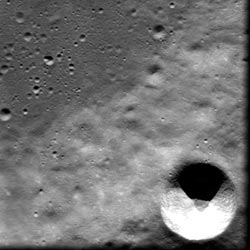Close-up on Cuvier crater ridge

This high-resolution image, taken by the Advanced Moon Imaging Experiment (AMIE) on board ESA’s SMART-1 spacecraft, shows the young crater ‘Cuvier C’ on the Moon. AMIE obtained this sequence on 18 March 2006 from a distance of 591 kilometres from the surface, with a ground resolution of 53 metres per pixel. The imaged area is centred at a latitude of 50.1º South and a longitude of 11.2º East, with a field of view of 27 km. The North is on the right of the image. Cuvier C, a crater about 10 kilometres across, is visible in the lower right part of the image. Cuvier C is located at the edge of the larger old crater Cuvier, a crater 77 kilometres in diameter. The upper left quadrant of the image contains the smooth floor of Cuvier, only one fourth of which is visible in this image. Credits: ESA/Space-X (Space Exploration Institute)
AMIE obtained this sequence on 18 March 2006 from a distance of 591 kilometres from the surface, with a ground resolution of 53 metres per pixel. The imaged area is centred at a latitude of 50.1º South and a longitude of 11.2º East, with a field of view of 27 km. The North is on the right of the image.
“This image shows the resolving power of the SMART-1 camera to measure the morphology of rims and craters in order to diagnose impact processes”, says SMART-1 Project scientist Bernard Foing, “or to establish the statistics of small craters for lunar chronology studies”.
Cuvier C, a crater about 10 kilometres across, is visible in the lower right part of the image. Cuvier C is located at the edge of the larger old crater Cuvier, a crater 77 kilometres in diameter. The upper left quadrant of the image contains the smooth floor of Cuvier, only one fourth of which is visible in this image.
Crater Cuvier was named after the creator of the comparative anatomy, Georges Cuvier, a 19th century French naturalist (1769 – 1832).
This high-resolution image, taken by the Advanced Moon Imaging Experiment (AMIE) on board ESA’s SMART-1 spacecraft, shows the young crater ‘Cuvier C’ on the Moon.
AMIE obtained this sequence on 18 March 2006 from a distance of 591 kilometres from the surface, with a ground resolution of 53 metres per pixel. The imaged area is centred at a latitude of 50.1º South and a longitude of 11.2º East, with a field of view of 27 km. The North is on the right of the image.
“This image shows the resolving power of the SMART-1 camera to measure the morphology of rims and craters in order to diagnose impact processes”, says SMART-1 Project scientist Bernard Foing, “or to establish the statistics of small craters for lunar chronology studies”.
Cuvier C, a crater about 10 kilometres across, is visible in the lower right part of the image. Cuvier C is located at the edge of the larger old crater Cuvier, a crater 77 kilometres in diameter. The upper left quadrant of the image contains the smooth floor of Cuvier, only one fourth of which is visible in this image.
Crater Cuvier was named after the creator of the comparative anatomy, Georges Cuvier, a 19th century French naturalist (1769 – 1832).
Media Contact
More Information:
http://www.esa.int/SPECIALS/SMART-1/SEMOB7BUQPE_0.htmlAll latest news from the category: Physics and Astronomy
This area deals with the fundamental laws and building blocks of nature and how they interact, the properties and the behavior of matter, and research into space and time and their structures.
innovations-report provides in-depth reports and articles on subjects such as astrophysics, laser technologies, nuclear, quantum, particle and solid-state physics, nanotechnologies, planetary research and findings (Mars, Venus) and developments related to the Hubble Telescope.
Newest articles

Bringing bio-inspired robots to life
Nebraska researcher Eric Markvicka gets NSF CAREER Award to pursue manufacture of novel materials for soft robotics and stretchable electronics. Engineers are increasingly eager to develop robots that mimic the…

Bella moths use poison to attract mates
Scientists are closer to finding out how. Pyrrolizidine alkaloids are as bitter and toxic as they are hard to pronounce. They’re produced by several different types of plants and are…

AI tool creates ‘synthetic’ images of cells
…for enhanced microscopy analysis. Observing individual cells through microscopes can reveal a range of important cell biological phenomena that frequently play a role in human diseases, but the process of…





















